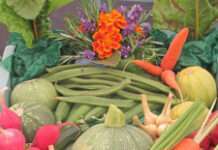K-State food safety specialist says different approaches are needed for different types of produce
MANHATTAN, Kan. – Now that summer is officially here, fresh fruits and vegetables are available everywhere, bringing with them the challenge of proper storage so we can enjoy every bite.
Kansas State University food safety specialist Karen Blakeslee said storage methods depend on the types of produce that we keep and where we keep them.
Summertime favorites such as fresh berries, cherries, grapes and stone fruit including apricots are highly perishable and need to be refrigerated. Berries, especially, can become moldy in just a couple of days. Apples, on the other hand, can be kept at room temperature if they’re going to be used within seven days.
Leafy greens, celery, carrots, broccoli, green beans and asparagus all need to be refrigerated as well. With asparagus, particularly, “sometimes it’s a good idea to put the bottom ends in a cup of water,” said Blakeslee, coordinator of the Rapid Response Center in the university’s Department of Animal Sciences and Industry. “It helps keep that produce hydrated so they don’t wrinkle up and dry out. Fresh basil is best stored at room temperature, but put it in a cup of water.”
Some kinds of produce need a little more ripening when they’re first brought home. Blakeslee recommends leaving nectarines, peaches, pears and plums on the counter so they can ripen and then put them in the refrigerator. “If peaches are a little hard, put them in a paper bag, fold it together and let the natural ethylene gas help the peaches ripen,” she said. “Another little trick is to place an apple in the bag, too.”
The key is to watch those fruits closely because they can ripen quickly.
Plenty of other types of produce can be left at room temperature: Bananas, melons, citrus fruits, pineapple, tomatoes, onions, garlic and potatoes.
Blakeslee offered a couple of tips for the trickier of these foods, though: If bananas are starting to show brown spots, they need to be refrigerated, frozen or made into a smoothie or banana bread. Onions and garlic should be stored away from potatoes because they can cause potatoes to sprout faster.
“With all produce, especially any of these that are at room temperature, once you cut them open – and if you have leftovers – you have to refrigerate them,” Blakeslee said.
Other tips for fresh fruits and vegetables:
• When selecting produce at a store or farmers market, Blakeslee recommends looking at the bottom of a melon rather than thumping or tapping on it to judge its ripeness.
“It’s better to look at the color of melon rind – where it sits on the ground – and look for a buttery yellow color,” Blakeslee said. “The thumping? Some people swear by it, and it can be deceiving. It’s better to look at that yellow color.”
Likewise, when the stem area of a cantaloupe is no longer green and you can detect the signature smell of the cantaloupe, it’s ready to be eaten.
• Take advantage of the plastic bags available in the produce section of the grocery store.
Keeping another barrier between fresh produce and fresh meats helps prevent any potential cross-contamination.
• Don’t wash leafy greens or berries immediately after bringing them home and before putting them in the refrigerator. That could shorten their shelf life.
“In most cases is it usually better to wait to wash produce until you’re ready to use them,” Blakeslee said, pointing to an alternative. “One little trick that I like to do – and it seems to work pretty well with leafy greens – I place a paper towel in the container to help absorb any residual moisture. It actually helps them last a little longer.
Gardeners often end up with far more produce than they can eat or give away while it’s ripe, and that’s where proper food preservation techniques come in.
Blakeslee and other K-State Research and Extension professionals all over the state teach courses in water-bath canning, pressure canning and proper approaches to freezing. There is also a wealth of information in the form of easy-to-use fact sheets produced by K-State Research and Extension specialists as well as other web-based resources such as the Rapid Response Center website, which Blakeslee maintains, and the K-State Research and Extension Food Safety webpage.
FOR PRINT PUBLICATIONS: Links used in this story
Food preservation fact sheets: https://search.k-state.edu/?qt=preserve+it+fresh&curtab=0&subsiteurl=www.bookstore.ksre.ksu.edu&subsitename=KSRE+Bookstore
Rapid Response Center: https://www.rrc.k-state.edu
K-State Research and Extension Food Safety webpage: https://www.ksre.k-state.edu/foodsafety/
FOR ONLINE PUBLICATIONS: An embeddable audio player of the Sound Living* radio interview for this story can be added using this code:
<iframe style=”border: none” src=”//html5-player.libsyn.com/embed/episode/id/19605110/height/90/theme/custom/thumbnail/yes/direction/backward/render-playlist/no/custom-color/512888/” height=”90″ width=”100%” scrolling=”no” allowfullscreen webkitallowfullscreen mozallowfullscreen oallowfullscreen msallowfullscreen></iframe>
* Sound Living is a radio program produced by K-State Research and Extension and is free to use and redistribute.
K State Research and Extension is a short name for the Kansas State University Agricultural Experiment Station and Cooperative Extension Service, a program designed to generate and distribute useful knowledge for the well being of Kansans. Supported by county, state, federal and private funds, the program has county extension offices, experiment fields, area extension offices and regional research centers statewide. Its headquarters is on the K State campus in Manhattan. For more information, visit www.ksre.ksu.edu. K-State Research and Extension is an equal opportunity provider and employer.
Story by:
Jason Hackett
785-532-5806
[email protected]
For more information:
Karen Blakeslee
785-532-1673
[email protected]





